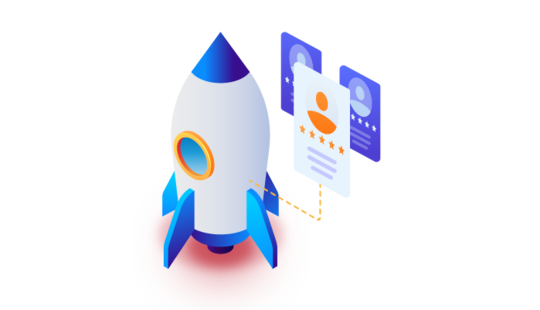-
Product Management
Software Testing
Technology Consulting
-
Multi-Vendor Marketplace
Online StoreCreate an online store with unique design and features at minimal cost using our MarketAge solutionCustom MarketplaceGet a unique, scalable, and cost-effective online marketplace with minimum time to marketTelemedicine SoftwareGet a cost-efficient, HIPAA-compliant telemedicine solution tailored to your facility's requirementsChat AppGet a customizable chat solution to connect users across multiple apps and platformsCustom Booking SystemImprove your business operations and expand to new markets with our appointment booking solutionVideo ConferencingAdjust our video conferencing solution for your business needsFor EnterpriseScale, automate, and improve business processes in your enterprise with our custom software solutionsFor StartupsTurn your startup ideas into viable, value-driven, and commercially successful software solutions -
-
- Case Studies
- Blog
The Role of a Product Manager in a Digital Startup: Goals, Responsibilities, and Skills
Product management is believed to have originated less than 100 years ago at the Procter & Gamble Company. At the time, Procter & Gamble was striving to promote their unsuccessful Camay product line.
To jump-start sales, they decided to hire “Brand Men” [PDF] who were to act in the product’s interests through close interaction with customers. The approach proved effective, and soon many other consumer goods firms adopted it.

As it was a century ago, the primary goal of a product manager today is to serve users’ interests and advocate users’ needs to stakeholders and teams. However, there is still no universally agreed upon description of a software product manager’s roles and responsibilities. This article describes what a PM does in our company and shares best practices and methods.
Who is a product manager?
The product manager, or PM, position has responsibilities in many areas. A professional product manager is, first of all, a great manager and strategist. Besides that, they are versed in programming, testing, design, business analysis, and other areas that touch upon software development.
Startups usually have a limited number of talents in-house, so a PM in a startup is someone who wears even more hats. An experienced PM who has worked with different projects is of great value for a startup business. In addition, such a specialist can take full responsibility for managing the product and the team, creating a practical development and promotion strategy.
The software product manager’s roles and responsibilities are many-sided and vary from company to company. At RubyGarage, this position requires a wide range of competencies, meaning a PM must specialize in many subject areas.
In RubyGarage projects, the PM is expected to can act as a:
- Customer advocate. The PM’s primary goal is to be customer-oriented, communicating business value to the product development team. The PM must clearly understand what will be best for customers, guide the team, and monitor the quality of the product at all stages of development.
- Team driver. The PM must have a proactive attitude and always be aware of the moods, needs, wants, pains, gains, and goals of users, clients, and the team. They should quickly respond to changes and adapt the project flow.
- Design partner. The PM must be competent to evaluate software usability and how a product’s design aligns with the brand philosophy. The UI/UX designer should create a hassle-free user journey for the best user experience, and the PM takes part in accepting the designer’s work and validating its quality.
- Product strategist. The product manager is responsible for creating a product strategy from ideation to implementation and support. They must see the product from different perspectives and make informed decisions for its timely delivery and successful promotion.
- Learning champion. Product management is a relatively new field in IT that does not have unified standards for most activities. That’s why each PM must constantly learn and enrich their knowledge.
- Value driver. A good product manager is constantly looking for how to improve the product. They invariably guess hidden users’ needs to boost product value. The PM always focuses on achieving business goals. Their primary task is to ensure the product is as valuable as possible for users and brings business success for its founders.
Key software product management roles and responsibilities in a technical startup
Tech startups usually focus on solving previously unsolved problems. Such an approach entails a high level of risk for the founding team. Without product expertise, startup founders cannot be sure whether the target audience will be interested in the product.
The PM makes the startup more predictable and creates a detailed scenario for product development and growth. A PM is necessary to find the perfect market fit through well-defined tools, methods, and frameworks. Product managers use advanced strategies and tactics that lead startups to business success.
Below are the critical duties of a product manager in a technology startup.
Product vision development
A product vision is the starting point for product development. A formulated product vision is the basis for further research to create a business model and segment the target audience.
Startup product owners often come up with abstract ideas without clear boundaries. As a result, there’s no clear understanding of the target market, competitors, and subject areas to explore.
The PM’s task is to pack the product idea into a clear definition with specific business goals and defined KPIs. In addition, the PM often organizes brainstorming and communication sessions with customers and stakeholders, especially at the initial stages of the product life cycle. As a result, the PM generates a formed product vision statement and product vision board.
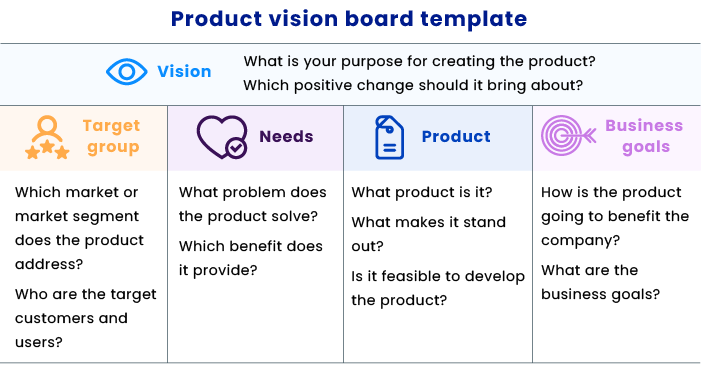
Market and competitor research
At this stage, the primary task of the PM is to determine the target market, identify a niche for product development, and analyze key competitors. Here is a list of activities for the market and competitor research stage.
Industry analysis
This analysis serves as an estimation of the product’s value for a particular audience: how the product idea fits into the market and meets users’ needs. Industry analysis covers:
- Industry size overview — how large and how competitive the industry is
- Industry growth prospects — how the industry has grown in the past and will continue to grow in the future
- Industry trends — how the industry is changing
- User segmentation and demographics — who your users are
- Industry profitability — how attractive the industry is that you’re entering
- Distribution channels — how users will reach your product
- Critical success factors — what factors can make the product successful
Market research
The PM proceeds to do detailed research of the target market and the product’s niche. At this stage, the PM investigates similar products and their development trends, studies direct competitors, determines the technological capabilities for product implementation, and so on. The results of market research must contain:
- Segmentation of market niches, their capacities, and their trends — what kinds of niches the market has, how they are changing, and the size of each
- Market opportunities, technological trends, and capabilities — how big the selected market is, how it works, and how it changes
- Competitors and their business models — who competitors are and how they run their businesses
- Needs of potential users — what your users need and whether you can offer it

Competitive analysis
A competitive analysis is investigating the main competitors on the market and answers questions such as:
How can they solve customers’ problems?
- What are their key focus areas?
- Who are their target audiences?
- What are the key value propositions competitors use to get their customers?
- How do they promote their products?
Given a problem, a PM must find out how competitors solve it, what solutions are the most valuable for users, and the advantages of your solution compared with competitors’.
Once the list of competitors is ready, it’s time to divide competitors into three categories:
- Direct competitors who have the same solutions to the same problems).
- Secondary competitors who have different solutions to the same problems
- Indirect competitors who solve a different problem but whose interests intersect with yours in some way
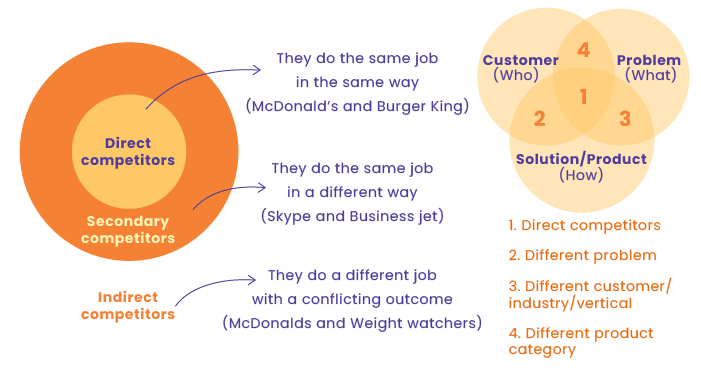
For most startups, only direct competitors matter. As the business grows and matures, the role of both secondary and indirect competitors rises. That’s why the next step is to delve deeper into your direct competitors. Below are the most common methods of analysis:
- Competitive comparison
- SWOT analysis
- Porter’s five forces analysis
- Strategic groups analysis
- Growth share matrix development
- Perceptual mapping analysis
Functional decomposition of competitors
To dig deeper into your competitors, sometimes it makes sense to decompose their products into subcategories. As a result, the product manager gets a list of different product features (modules, epics, use cases). Finally, they clearly understand how the competing product is designed.
Segmentation and needs analysis
Now it’s time to understand the segmentation structure and the specific needs of potential customers. This step requires collecting some additional data about potential customers.
A PM groups the findings into several ideal customer profiles (ICPs) for segmentation of the target audience — descriptions of the types of customers you should try to sell to.
For each ICP, the PM must identify the buyer persona — in other words, the PM must analyze who will buy from you. Once this analysis is complete, the PM can form the ICP, define buyer personas, perform audience segmentation, understand the customer journey, and control customer behavior.

Development of business model hypotheses
The next step is to form hypotheses for further business model development. Hypotheses are assumptions about specific things tied with the product or entities related to it. The Lean Canvas by Alexander Osterwalder is a proven hypothesis development framework.
Business model hypotheses are the riskiest elements of the business model a PM must develop. They help you:
- Visualize your idea
- Better communicate your idea to other stakeholders
- Iterate your idea step by step to success
The assumptions found within this step will become a basis for further customer development. All of them will go through a validation process.

Problem hypotheses
A problem is a thing that makes the existence of each startup purposeful. For example, some people or companies face difficulties or opportunities. Your startup can potentially solve these problems or catch opportunities. Hypotheses about problems must include references to existing ways of solving the problem or seeing the opportunity.
Solution hypotheses
This is the second part of the puzzle: a way, method, or approach to solving your product’s problem. The problem and solution hypotheses usually form the basis of the product. If one or both are flawed, the product has a relatively low chance of success.
Key metrics hypotheses
A startup's key metrics track key business activities. If those metrics are correctly chosen, changes in them make it possible to quickly detect any positive or negative changes. The challenge is selecting the proper metrics to track. The typical vital metrics for a digital startup are the number of active users (daily, monthly), customer acquisition cost, churn rate, retention rate, and compound monthly growth rate.
Key partners hypotheses
Every business partners with other companies, governments, or other non-customer entities. Some partners are essential or at least highly important for the business to keep operating. For example, a partner may be an exclusive parts supplier for manufacturers, or a partner can be Amazon for merchants selling on the Amazon marketplace. The PM must guess the key partners very carefully.
Unique value proposition hypotheses
A unique value (or selling) proposition (UVP/USP) is what makes your product different from others. A UVP or USP isn’t about having a unique brand name or a unique set of founders. Instead, a UVP describes why your product is better at solving the problem it solves. Typically, it answers how and why customers should choose your product over others.
Unfair advantage hypotheses
The unfair advantage is similar to the UVP but not the same. This is an advantage that your competitors are unable to offer or will find it very hard to copy, such as patented proprietary technology. Usually, PMs consider an unfair advantage as a product’s main competitive advantage.
Channels hypotheses
Channels are the ways your business communicates with the target audience. There are tons of offline (outdoor advertising, exhibitions) and online (social media, personal blog) communication channels. Remember that trying to cover as many channels as possible in your hypotheses isn’t the best option. Instead, start listing the most apparent channels, then add channels that are less attractive in your case.

Customer segments hypotheses
It’s likely that your product is aimed at several different segments of target customers. The more detailed you'll describe them, the better.
Cost structure hypotheses
A product manager controls all business-related spending. Think twice; you shouldn’t forget essential cost items, including both fixed and variable costs. As a result, form your hypothesis about cost structure, covering all these spendings.
Revenue streams hypotheses
There are seven revenue-generating streams described in the Business Model Canvas:
- Asset sales (a retail chain sells one of its stores)
- Usage fees (highway tolls)
- Subscription fees (Netflix)
- Lending/leasing/renting (house rent)
- Licensing (royalties for patents and other intellectual property)
- Brokerage fees (commissions for salespersons and brokers)
- Advertising (profits from banners, paid articles in media, etc.)
A PM’s task is to offer those streams that will generate revenue the best with the given product. To do X, you can use a simple yet efficient framework called a hypotheses statement: IF [cause] THEN [effect] BECAUSE [rationale]. But the best option is a Lean Canvas.
Customer journey map hypothesis development
A customer journey map (CJM) shows how the customer acts during the customer journey. Thanks to the CJM, you can visually control brand impressions at all stages, eliminating bottlenecks. You can step into the customer’s shoes, analyze the sales funnel, and fix flaws to increase your conversion rate.
A PM forms hypotheses for each separate CJM section:
- Phases of the purchase journey (a high-level process overview, from awareness to purchase; the model looks discrete, but the authentic customer journey isn’t sequential)
- Touchpoints (places where the customer interacts with the brand)
- Customer thoughts and actions (customer feedback helps you better understand user behavior)
- Pain points (what’s stopping our customers...) (the issues users can face during their journey)
- The customer’s emotional journey (a map of customers’ emotions at any moment in their journey is the most valuable section)

Customer Discovery as part of Customer Development
Customer Development in a nutshell
The Customer Development process consists of four main stages:
- Customer Discovery
- Customer Validation
- Customer Creation
- Company Building
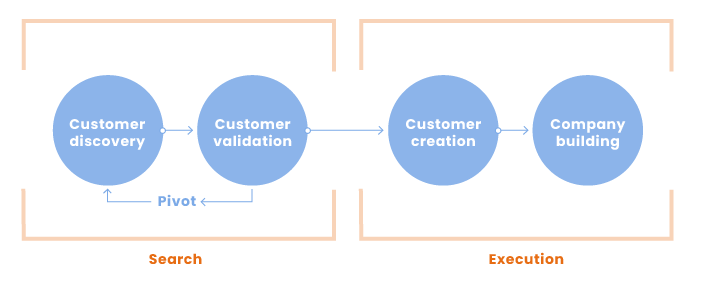
Customer Discovery
Customer Discovery is a product creation methodology authored by Steve Blank and the first step in Customer Development implementation. The Customer Discovery process aims to validate previously formed hypotheses about the problem, solution, market, and revenue streams based on interactions with potential customers.
The PM’s main task at this stage is to design a Customer Development experiment that contains the following steps:
- Form a plan (strategy)
- Validate hypotheses
- Conduct the experiment, or test the hypotheses
The quality of the experiment is crucial. The better it is designed, the more chances the product has to succeed. Here is a list of proven methods and tools that help you conduct Customer Discovery experiments in the best possible way:
- In-depth interviews, both offline and online
- Focus groups
- Telephone interviews
- Surveys
- Workshops with target audience trustees
- Launch of landing pages for understanding users’ behavior and demands
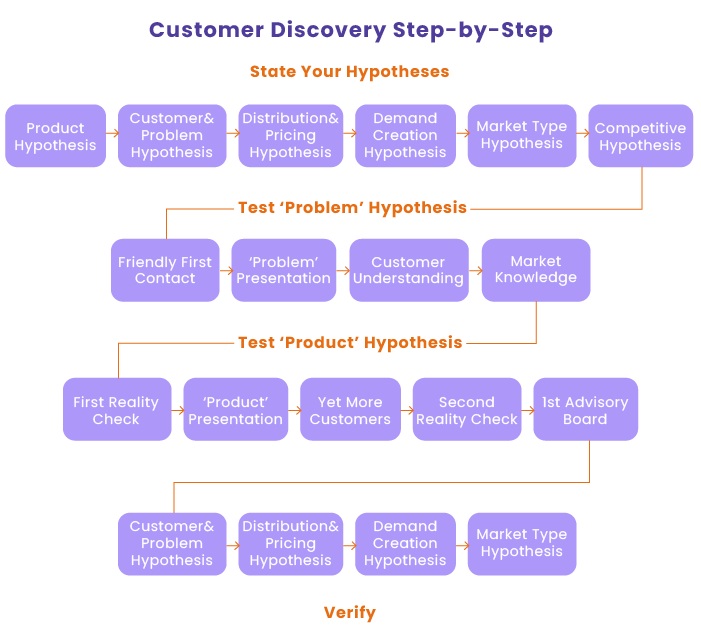
Product planning (product strategy development)
With the product discovery results in hand, the PM starts product planning. This stage aims to analyze the results of the previous step, then form a plan or strategy and determine the feature set.
Feature set design
Working with business analysts, the PM forms the feature set, using a feature breakdown list (FBL) and user story map as the primary tools. As a result, the features ready for implementation are presented within the following FBL structure:
- User role
- Module
- Epic
- Use case
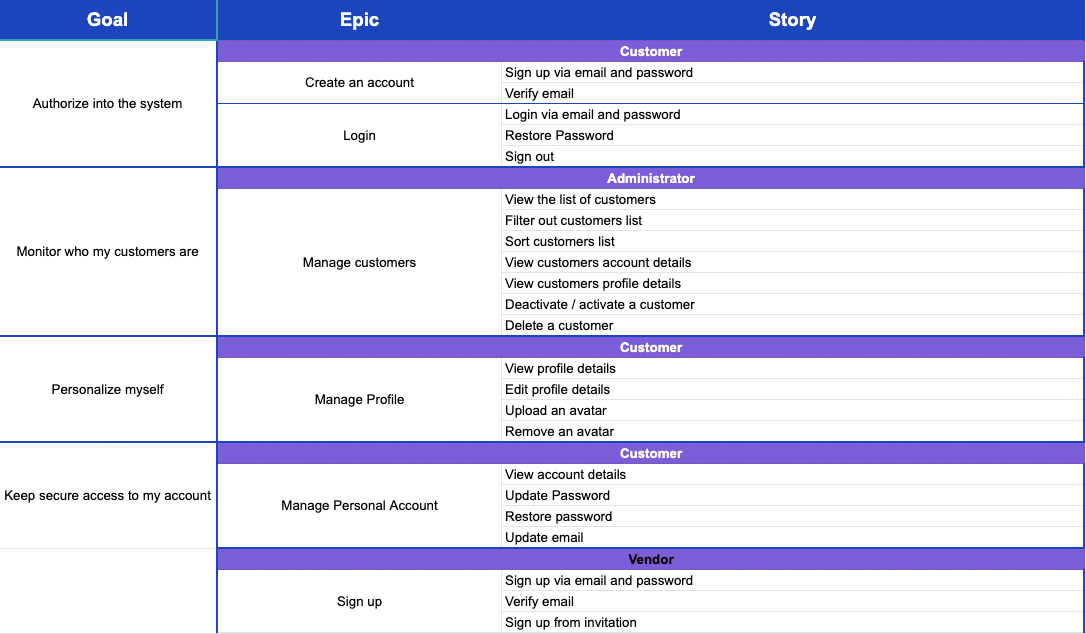
The alternative approach is user story mapping. This approach is illustrated in an example below:
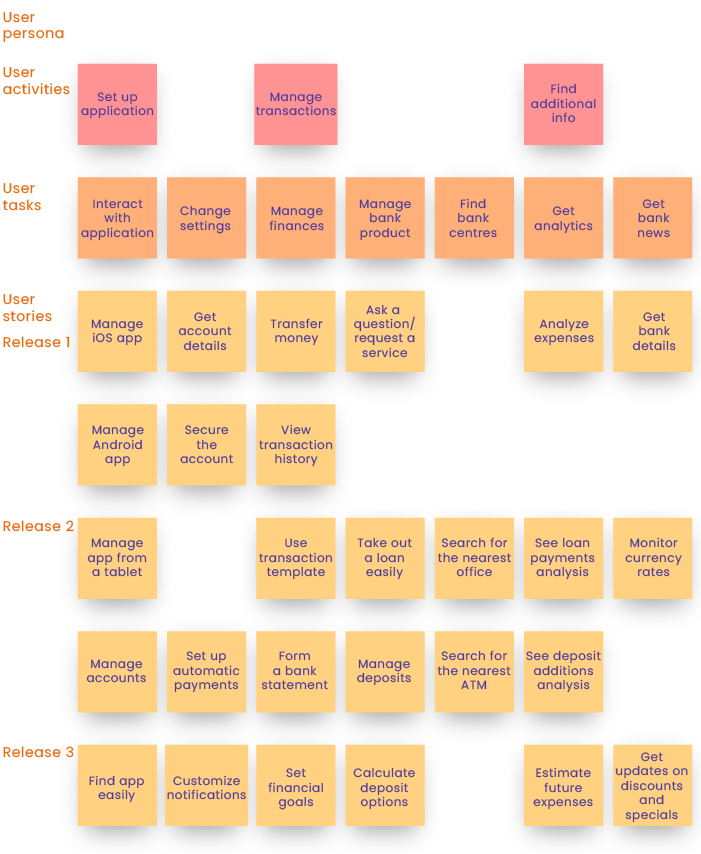
Feature set estimation
Now it’s time to estimate the overall effort required to implement our feature set. This estimation includes all the stages of the software development process, from business analysis to user acceptance testing.
Use story points instead of dollars or working hours for making estimates. The amount of time required for completing a task depends on the skills of the engineer working on it.
Project team setup and scheduling
Understanding the effort required for developing a product opens a way to set up a development team.
The product manager must clearly understand what roles will take part in product development. Moreover, in Agile teams, different roles start their work at different stages. The manager must take the development process fully under control. This means that the PM is responsible for:
- Release planning
- Identifying dependencies between features
- Optimal resource planning for achieving the best possible performance within an acceptable budget
When the team is formed, the PM creates product development milestones and calculates release dates. Then, the product manager develops a schedule based on the feature set estimations calculated before.
Project budget design
At this point, we have a development schedule, a feature set, and effort estimation in story points. The next step is to set a product budget. The budget must cover not only developers but also operations and marketing teams.
MVP scope design and estimation
The feature set you’ve formed at one of the previous stages is too narrow for an MVP. The MVP scope design is a process of rigid prioritization, which results must include just a few of the essential features.
Remember that an MVP is not only minimum but also viable. In other words, your MVP must perform its primary task. The final flourish of the scope is estimating the MVP, which is far easier than estimating the overall project thanks to a more straightforward feature set.
Technology stack proposal
Now you clearly understand the business needs and requirements as well as the budget, terms, and other project variables. That makes it possible to identify the tools, utilities, technologies, and libraries that will be used for project development.
Product design
The proven product hypotheses and insights revealed after the product launch makes it available to form the basis for the further product development strategy. The PM manages the creation of new product features using prioritization. During the product design stage, the product manager:
- Develops an in-depth product requirements list (business requirements, functional requirements, non-functional requirements, product glossary)
- Participates in creating a database architecture model (with a business analyst) (product data model)
- Participates in UX research with the design team (then designs UX research report)
- Manages UI and UX solutions development (complete UX solution, product design system, responsive UI solution)
- Takes part in UI/UX acceptance testing
Product development
Product development is a multifunctional process involving different roles, from business analysts and designers to developers and testers. The PM acts as a facilitator throughout the development process, managing and prioritizing the product backlog, facilitating project management activities (planning, budgeting, scheduling, communication, etc.), planning sprints, and participating in acceptance testing in the role of a receiver.
Customer validation
Just after the product launch, the PM starts validating customers. Customer validation should be conducted as early as possible. This stage helps avoid the risk of cost overruns if the MVP or pilot release fails.
There are three things a PM must keep in focus: the product, the market, and the problem/solution. A PM’s duties with regard to customer validation consist of:
- Analyzing the behavior of early users
- Conducting user surveys
- Conducting customer interviews
- Updating the product strategy based on validation results
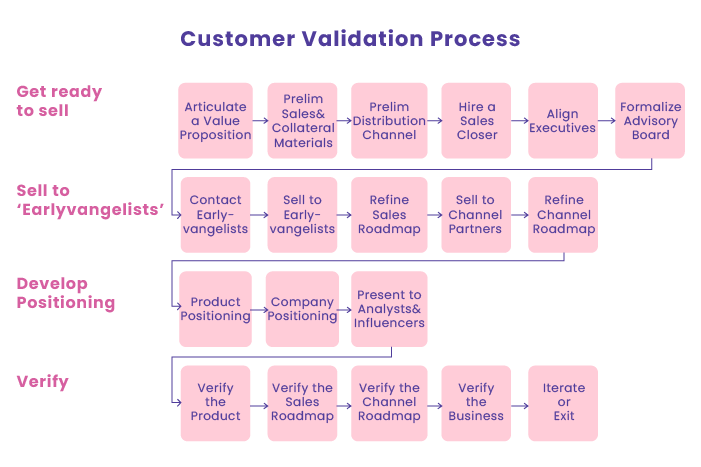
Customer creation
During the customer creation process, the product manager establishes a sales flow and works on enlarging the user base. To do this, the PM observes real users, analyzes their behavior, and thinks of steps to boost the company’s marketing efforts.
The customer creation flow depends on the type of target market (new, established, niche) and the nature of the product. The process is aimed at increasing demand using user acquisition marketing activities such as pre-launch campaigns, one-time offers, user-created content, and exclusive offers.
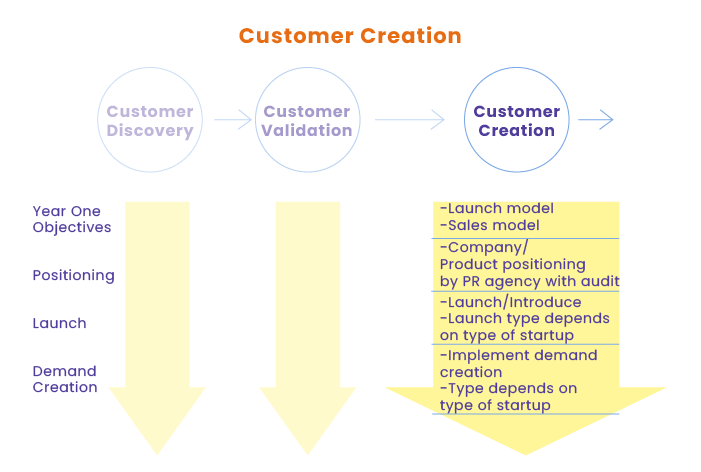
Company building
Company building is about launching and scaling the customer’s business while the product is growing. The PM should have a broad vision and a clear understanding of the product’s place and how it affects business development. Adjusting the product strategy according to the company’s goals, the PM corrects and improves business processes, helping the business grow.
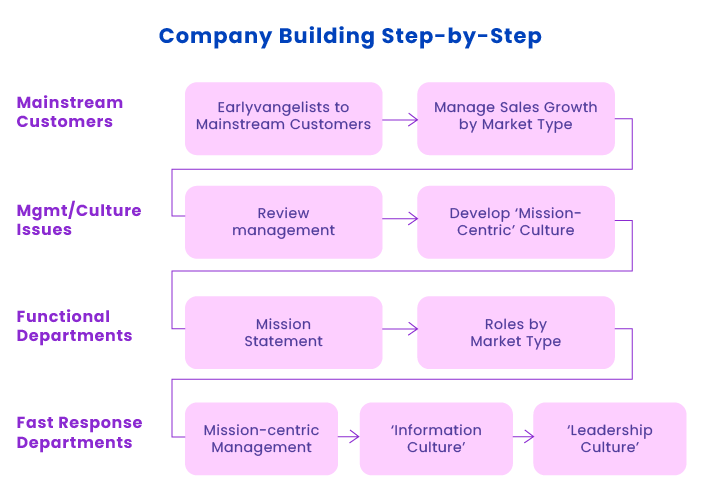
Ongoing product support and maintenance
A product manager’s job doesn’t end after the product launch. The product manager monitors how the product performs and what can be done to help it serve users better. At this stage, the PM may suggest adding new features.
Why hire a product manager in a startup?
A startup is in a similar situation to that of an employee who may be skilled but has no idea how things work in their new company. Mentors — experienced colleagues who perfectly understand the internal processes — often help new employees adapt faster.
The product manager takes on the role of mentor for startups. The PM confidently leads a startup to success through a deep understanding of the market, product, competitors, and customers. Knowing all the nuances of product management, a PM chooses the most effective methods to develop and promote the product. Product owners should take a PM as their right-hand person because the PM knows how to deliver the top result at the lowest price. Using in-depth expertise, a product manager prevents many problems and puts software development on the right track.
|
1 |
Avoid investing in the development of unproven ideas and a product that does not solve the problem of the target audience |
|
2 |
Keep the team focused on the right product priorities and the clearly articulated business value that each product feature will bring |
|
3 |
Achieve product-market fit in the shortest possible time with minimal investment |
|
4 |
Coordinate the product team at each product design stage: data collection, requirements identification, creation of functional and non-functional specifications |
|
5 |
Guide product marketing and sales, establish a sales flow, define purchase funnels, and set up communication channels |
|
6 |
Quickly respond to users’ insights and changes in the market situation with an updated product strategy and tactics |
|
7 |
Prioritize business interest and business value and develop a product with the most significant possible benefit for the company |
Product managers solve issues
Below is a list of critical issues that a PM can resolve and avoid:
- Investing in the wrong product. The PM actively participates in the Customer Development process and validates product hypotheses. When a good PM rules the product, there is a slim chance of launching a product without product-market fit.
- A mismatch between the product and target users’ needs or customers’ expectations. The PM doesn’t launch product development until they understand what users want.
- Overpriced development. The PM always focuses on bringing the highest value at the lowest cost. They define the right MVP through task prioritization and facilitation of a product management process.
- Short product life cycle. The PM works on a product support and maintenance strategy. In addition, they take care of customer success development to ensure users enjoy using the product as long as possible.
- Messy processes. The PM sets up a straightforward and convenient workflow for all team members.
- Weak lead generation and sales process. The PM develops a go-to-market strategy and monitors its effectiveness after the product is released.
- Wrong marketing communication with the target audience. The PM selects the most appropriate channels to deliver the product to users based on a deep understanding of the target audience’s needs.
- Lack of development strategy and priorities. The PM manages the backlog and prioritizes tasks to get the desired results faster and at a minimal cost.
- Lack of business value understanding by the development team. The PM constantly communicates with the client and team to understand what they’re doing, why, and how.
- Slow product improvement. The PM conducts customer discovery and customer validation to ensure the product evolves at the right pace and meets the latest customer expectations.
Summing up
The role of a product manager in a startup is vast and essential. Covering activities from various domains, the PM rules the product life cycle, bearing responsibility for successes and failures.
A professional PM has strategic thinking, extensive experience, and a proactive mindset. They can quickly make decisions and adapt to changes. The skillset required for succeeding in the PM role is broad and combines knowledge of several professions.
The primary goal of the product manager in a startup is to create a product that sells well. To do this, the PM focuses on the end-user, studies their needs, and acts on the users’ side. On the other hand, the product manager advocates for the product owner’s interests and works under conditions of limited resources. Therefore, they build a product strategy to achieve the desired value at the lowest cost.
FAQ
-
Surely yes! The role of a PM is highly demanding, so only an expert can handle it efficiently. This means that having a product manager in-house is rather risky.
What's to outsourced product management, it brings a string of benefits:
- You will share risks with the contractor
- You can significantly reduce costs
- A proper partner can provide better efficiency
- A contractor has a ready-made process, previous experience, and answers you don’t have.
RubyGarage will help you with this. Our Product Management Competency Center is filled with highly skilled professionals who are able to handle products of any complexity.
-
A product manager is a person who is responsible for identifying the customer’s needs, analyzing these needs through the lens of the business’s needs, and formulating a vision of the product that the development team then turns into reality. In other words, the product manager manages all aspects of a software product’s lifecycle with the help of data and feedback from real users.
-
The role is responsible for:
- Product vision development
- Market and competitor research
- Development of business model hypotheses
- Customer journey map hypothesis development
- Conducting Customer Discovery
- Product planning
- Product design
- Product development control
- Customer validation
- Customer creation
- Company building
- Ongoing maintenance and support management.









